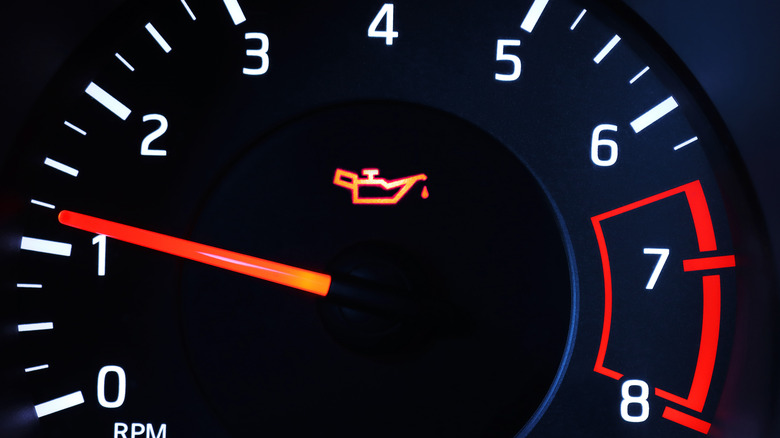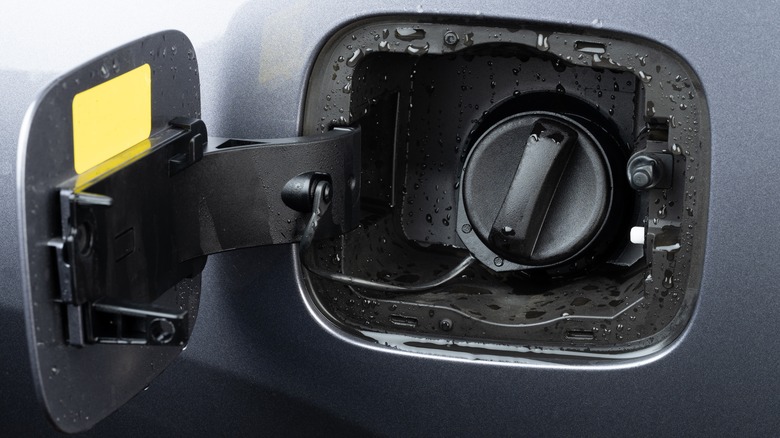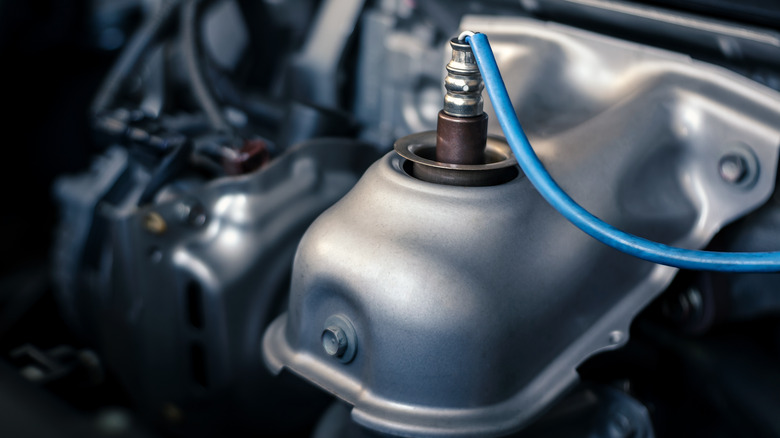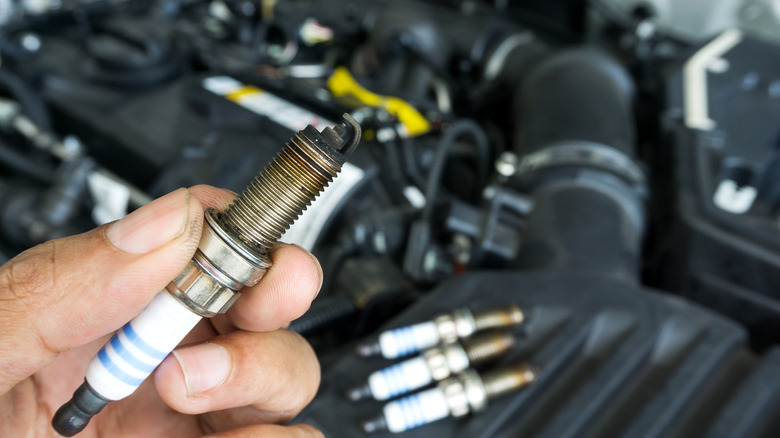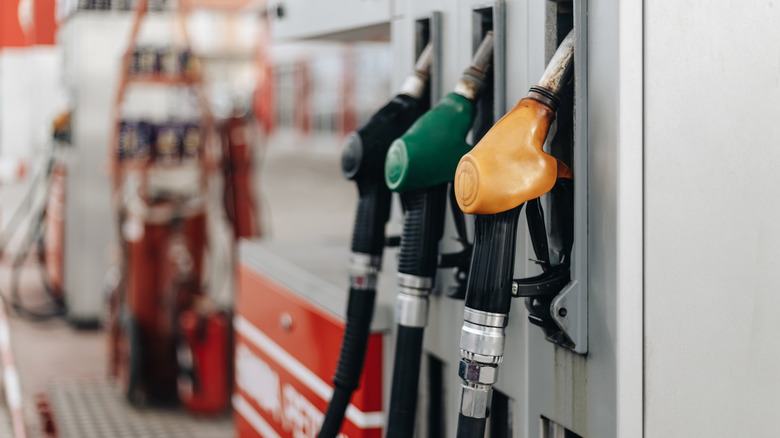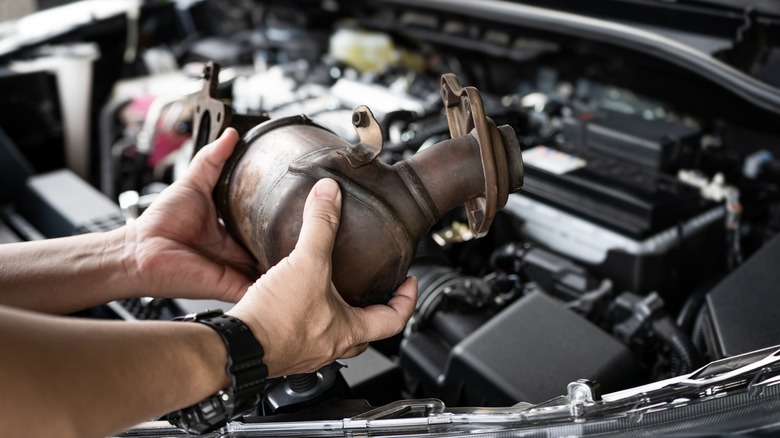5 Reasons Why Your Check Engine Light May Be On
The dashboard of your car provides plenty of useful information while you're driving, from the speed you're traveling at to the amount of gas left in your tank. The check engine light is another dashboard staple, but because the information it provides isn't as specific as other lights and meters, you might be tempted to ignore it. Conversely, you might start to panic the moment it lights up, assuming the worst and envisioning costly bills from your mechanic.
There are many different reasons your check engine light may be on — ranging from minor inconveniences to dangerous problems that should be fixed as soon as possible. That's why you shouldn't freak out or ignore the sensor when you notice it, but instead hone in on the exact cause and respond accordingly. The quickest way to determine what's setting off your check engine light is by buying and using an OBD2 scanner. This relatively inexpensive device can plug into your vehicle's computer and assess what issues your car is suffering from. This is the same type of scanner used by mechanics, and it can save you a lot of money by skipping a trip to the body shop.
If you don't have an OBD2 scanner on hand, there are a few common problems that could trigger your check engine light. By knowing what they are, you can quickly check for yourself if they're what's lighting up your dashboard, and you can possibly even troubleshoot and correct them yourself without spending a ton of money. Here are five reasons why your check engine light may be on.
Loose or broken gas cap
A common explanation for why your check engine light is on is a loose or broken gas cap. In this capacity, the light is useful as a reminder to make sure you've replaced it after refilling your tank, just as your car will usually alert you when you leave a driver-side or passenger door ajar. If the hinge cover or another part of your cap is broken, you'll need to put a little more effort into fixing it and getting the check engine light to go away.
What you shouldn't do is ignore the issue, even if it seems like a minor one. Driving without a gas cap can mess with the recirculation in your fuel system and cause fuel to evaporate from your tank. Gas is already expensive enough — you definitely don't want to be paying for more than you already need because you're letting some of it vanish into the ether. Evaporating gas shouldn't be taken lightly, which is exactly why vehicles are built with sealed evaporative systems and have sensors closely monitoring this part of your car in the first place.
The check engine light may be sensing leaks caused by bigger issues than just your gas cap, such as a problem with one of the plastic recirculation lines, connectors, or fittings in the system. If replacing your gas cap doesn't solve the issue, you may need to get these checked out. The best thing to do is to prevent leaks in the first place by making sure you always replace your gas cap carefully when pumping gas. Topping off your gas tank is also a big mistake and could cause serious damage to the cap or other parts of your car.
Faulty sensors
Your vehicle is loaded with sensors that measure everything from oxygen to coolant temperature, so it's not uncommon for at least one of these sensors to malfunction from time to time, in which case your check engine light may begin glowing. The oxygen sensor that measures how much unburned oxygen is in your car's exhaust system often operates in an environment exceeding 800 degrees, so it shouldn't be a surprise it'll eventually need to be replaced. A broken oxygen sensor can lead to the air-fuel mixture in your engine becoming inefficient, and you'll be burning more gas than you should be. Worse, a faulty oxygen sensor can also cause damage to the spark plugs and catalytic converter in your vehicle, causing even bigger headaches down the road.
Likewise, the mass airflow sensor in your car can often be faulty, especially as it gets gunked up from use. This can lead to your engine jerking, dragging, stalling, or failing to start, among other problems. You can purchase specialized cleaners or save money by putting your mass airflow sensor in a Ziploc bag filled with rubbing alcohol to remove grime and dirt. Doing this twice a year or when you're changing your oil can prevent problems before they start or worsen and trip the check engine light.
In addition to the oxygen sensor, coolant temperature sensor, and mass airflow sensor, your check engine light may indicate problems with your engine oil sensor, throttle position sensor, fuel pressure sensor, or coolant level sensor. The best way to determine a specific issue is by seeing what codes your OBD2 scanner brings up when plugged into your vehicle's computer.
Spark plug issues
Spark plugs are relatively affordable and simple components of your vehicle, but they're important nonetheless, as are the ignition coils that give them the electricity they need to ignite the fuel/air mixture in your engine. Issues with your spark plugs, coils, or spark plug wires can activate your check engine light, so you may want to inspect them when the pesky warning shows up on your dashboard.
Many modern cars contain multiple coils for each cylinder in your engine, which means there are more places for something to go wrong. Spark plugs can wear down or become fouled by oil, carbon, or fuel. They can also blister if they're running too hot for too long. If you know how to tell if you have a bad spark, you can identify whether or not they're the issue pretty quickly after popping your hood. Replacing them yourself isn't that hard, and spark plugs typically cost less than $20, while coils are around $50 — so you can save a lot of money by fixing this issue in your garage rather than having a mechanic do so at a body shop.
Older vehicles also use wires to connect spark plugs and coils, and if damaged, these wires can set off your check engine light. If your engine sounds shaky while idling, has a significant drop in performance, or does not get as many miles to the gallon as it usually does, it could be a sign that your spark plug wires are causing your Check Engine Light to illuminate. Fortunately, these are also cheap and easy to swap out yourself.
Bad or incorrect gas in your tank
Your vehicle likely doesn't have a dedicated light for when you have a bad tank of gas, but if you do, it could trigger your check engine light. Gasoline can expire, or impurities in the mixture could make it very hard for your engine to properly run on it. The gas could also be perfectly fine, but not the right kind for your car. If you're driving a higher-performance vehicle that is designed to use the more expensive premium fuel offered by gas stations (typically octane grade 91 to 94), don't try to save money by feeding it the cheaper stuff, which is usually octane level 87.
Conversely, if you own a car that runs fine on regular fuel, that doesn't mean paying extra for the higher-octane premium gas will give you better performance. You should just go with the type of gas your engine is designed to use. If you're unsure what that is, check your owner's manual to see what octane levels your engine requires. If you do have a tank filled with bad gas or the wrong type of fuel, you can try to keep driving until it's all used up, but this can hurt the performance of your engine or cause it to overheat. The best way to get rid of the check engine light in this situation is to have a mechanic drain your fuel tank completely before filling it back up with proper gasoline.
Catalytic converter issues
Catalytic converters have been an important part of engines for decades, helping keep carbon monoxide out of the environment. If yours isn't working properly, your engine will have lower performance and fuel economy and could even fail completely. You also won't pass your next vehicle inspection. If your car is making weird noises or the smoke coming out of your tailpipe is thicker or a different color than usual, it could be from issues with your catalytic converter. A check engine light could also mean there's something wrong with it or that, perhaps, it's missing entirely (which is very possible, even as California strives to end catalytic converter theft).
You'll definitely want a mechanic to replace a busted catalytic converter, but you'll also want to inspect the exhaust system and rest of your engine as well, as issues with other components may have damaged it in the first place and could do the same with a new one. Also, make sure you (or a mechanic) perform regular oil changes and you consistently get in enough highway miles with your car to keep your current converter free of clogs and in good shape to avoid setting off another check engine light down the line.
